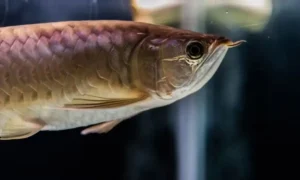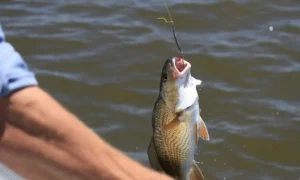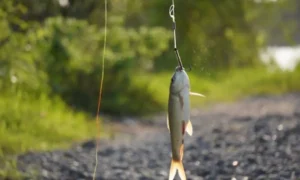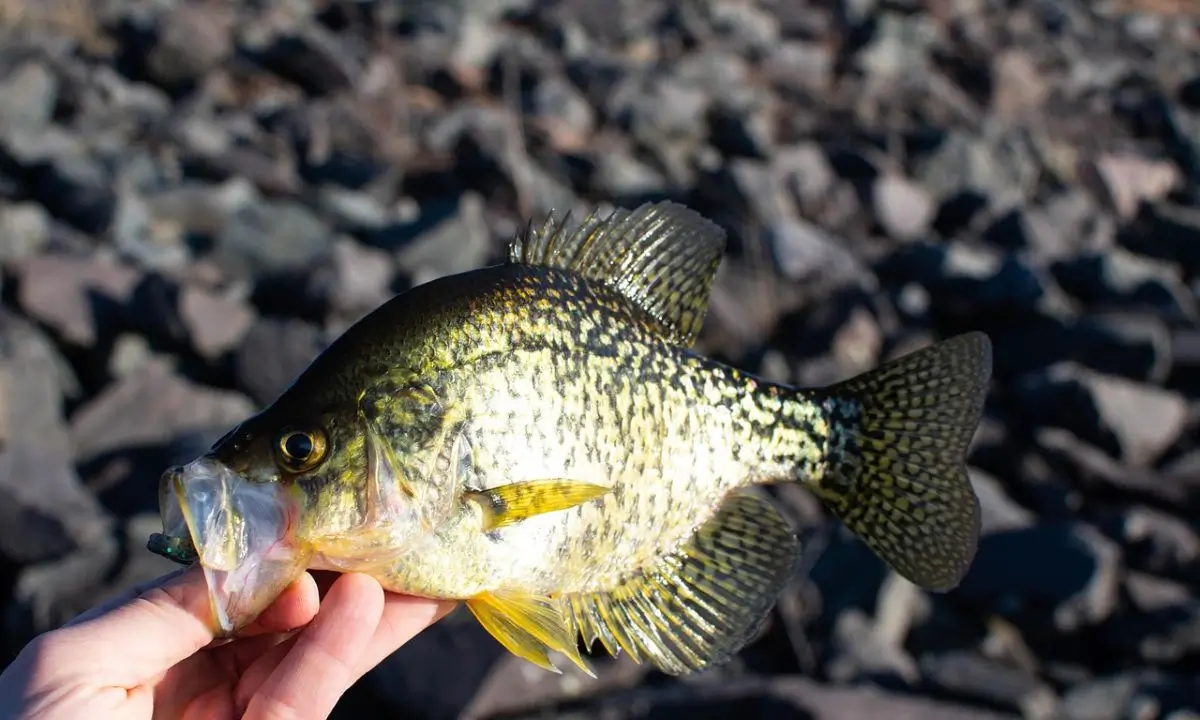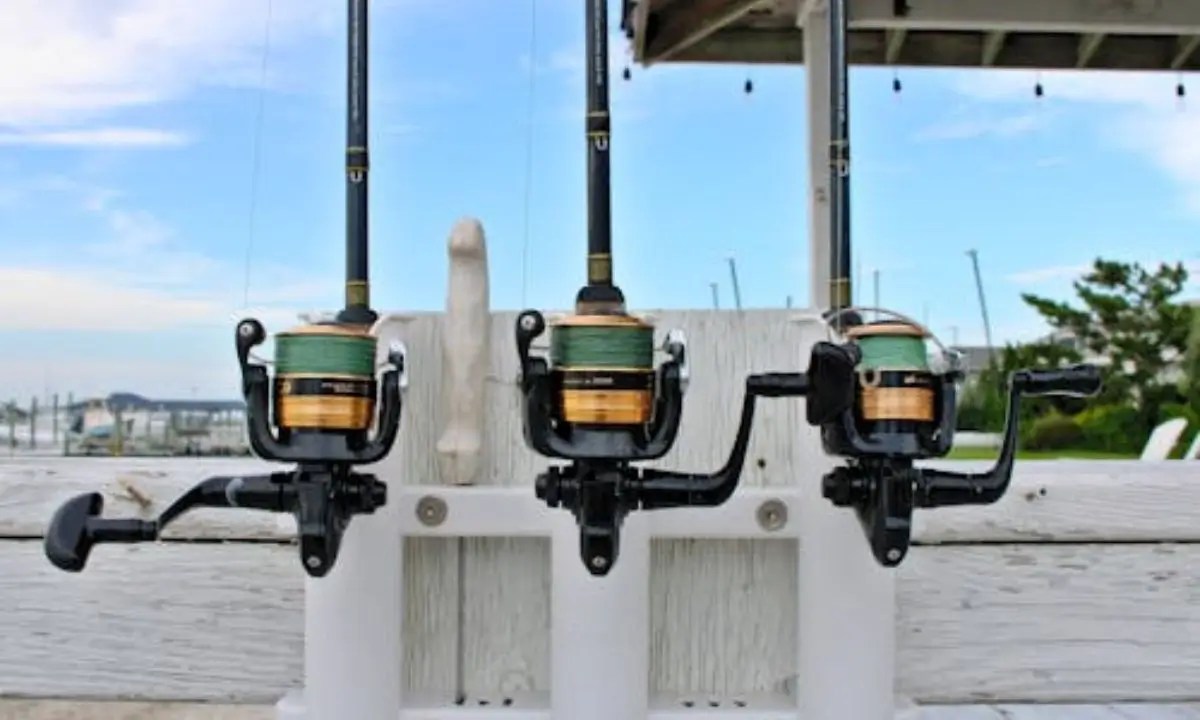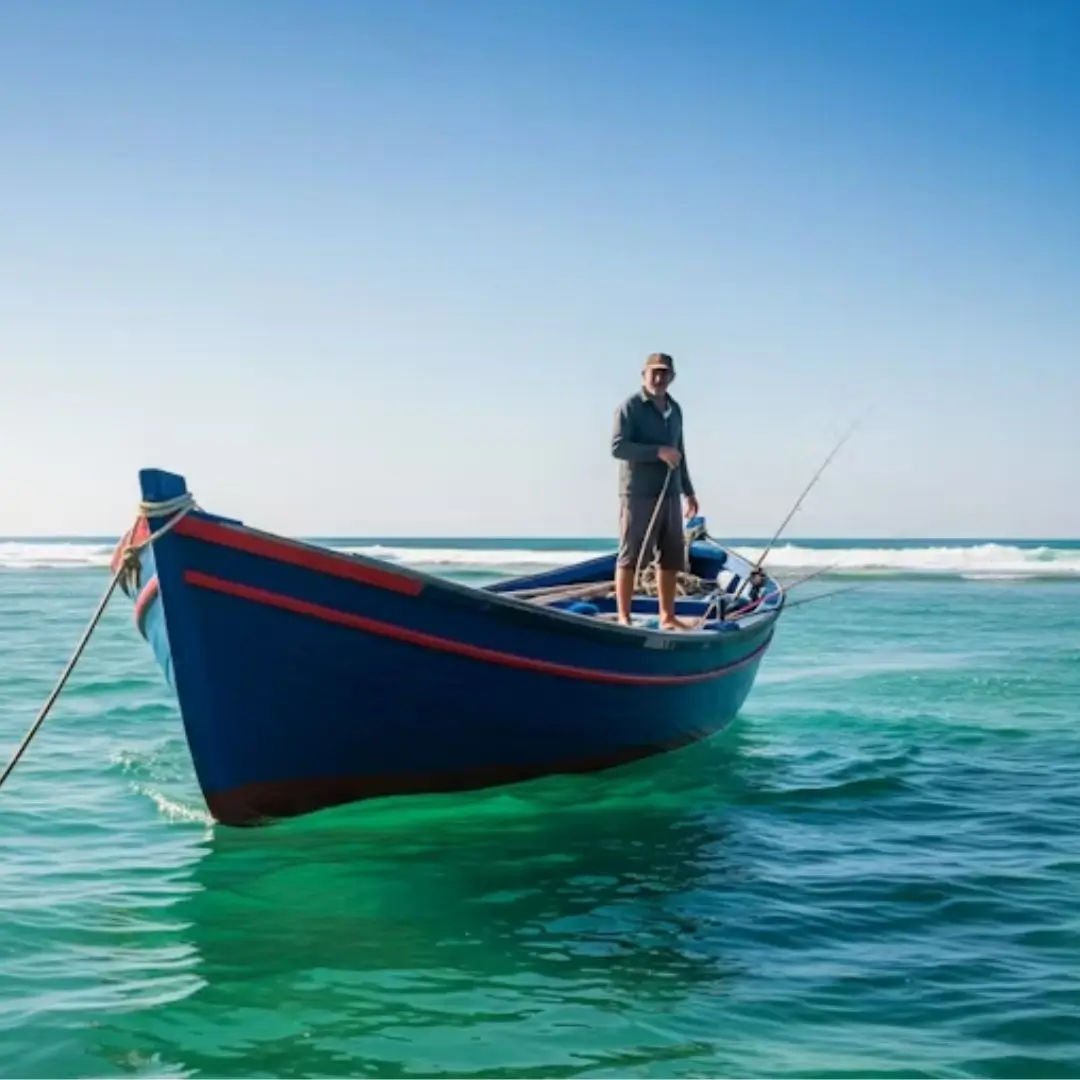Yes, you can catch boundary water fish with a braided line. It offers strength, long casting distance, and sensitivity, making it effective for species like bass, pike, and walleye. However, anglers often use a fluorocarbon or monofilament leader to reduce visibility in clear waters.
✅ Introduction
Can you catch boundary water fish with braided lines? Many anglers ask this question when planning their trips, especially in 2025, as fishing rules and techniques continue to evolve. Braided fishing line is popular because of its strong build, long casting ability, and excellent sensitivity, but boundary waters present unique challenges. Clear water, strict fishing regulations, and different fish species often make anglers confused about whether braided line is the best choice.
In this guide, we will explore how a braided line works in boundary waters, its pros and cons, fishing techniques, and the rules you need to follow. Whether you’re targeting bass, walleye, or pike, this article will give you practical tips, comparisons with other lines like fluorocarbon and monofilament, and expert advice for boundary water fishing in 2025. details Fishing Line Last
✅ What is Boundary Water Fishing? (150–200 words)
Boundary water fishing means catching fish in lakes and rivers that sit along or between two borders, such as the U.S. and Canada. The most popular example is the Boundary Waters Canoe Area Wilderness (BWCA) in Minnesota, a protected region known for its clean waters, natural beauty, and strict fishing rules. Anglers from all over visit this area to enjoy fishing for species like walleye, northern pike, smallmouth bass, and lake trout.
Fishing in boundary waters is different from regular lakes because the ecosystem is more sensitive, and regulations are closely monitored. For example, some lakes have rules about line type, leader length, and daily catch limits. Since the water is usually very clear, the choice of fishing line—braided, fluorocarbon, or monofilament—plays a big role in success. Understanding the basics of boundary water fishing helps anglers plan better trips, stay legal, and improve their chances of catching fish in 2025.
What is a Braided Fishing Line?
A braided fishing line is made of multiple strands of strong synthetic fibers woven together. Unlike monofilament, braid has almost no stretch, which gives anglers better sensitivity and more control when fishing. It is known for its strength, durability, and low memory, making it ideal for long casts and heavy fish.
For BWCA fishing or boundary waters canoe area fishing, braided line allows you to fish deeper waters or heavy cover areas where fish hide. This line works well with different lures, including soft plastics, crankbaits, spinnerbaits, and spoons.
Can You Catch Boundary Water Fish with Braided Line?
Yes! The braided line is excellent for catching multiple species in the Boundary Waters. Fish like smallmouth bass, northern pike, walleye, and lake trout respond well to braid because it offers precise control, especially in areas with weeds or rocky bottoms.
Using a braided line paired with a fluorocarbon leader makes it almost invisible to fish while keeping the strength needed for bigger catches. If you are targeting multiple species in one trip, a braided line is a lightweight, reliable choice, making it easier to pack light for BWCA fishing.
✅ Understanding Braided Line
Braided fishing line is one of the most trusted choices among modern anglers because of its strength and sensitivity. Made from woven synthetic fibers like Spectra or Dyneme, the braided line is thinner yet stronger than traditional monofilament. This allows anglers to spool more lines on their reel while still enjoying excellent casting distance. For boundary water fishing, where long casts and handling strong fish are common, braided line often becomes the first choice.
One of the biggest advantages of braided lines is its zero stretch feature. This gives anglers instant feedback, making it easier to feel even the lightest bites from fish like walleye or bass. It is also very durable and works well around rocks, weeds, or timber, which are common in boundary waters.
However, braided lines also have some drawbacks. Its high visibility in clear water can sometimes scare fish away, which is why many anglers add a fluorocarbon or monofilament leader. Another issue is that knots must be tied carefully to prevent slipping.
In 2025, anglers who fish in regulated areas like the Boundary Waters need to understand when and how to use braided lines effectively. With the right setup, it can be a powerful tool for catching more fish. more into Crappie Fishing Rod and Reel
When Not to Use Braided Fishing Line
Even though braid is strong, there are situations where it is not ideal:
- Clear, shallow water where fish are line-shy
- Ice fishing, because braided line can freeze and lose flexibility
- Situations requiring stretch to absorb sudden fish pulls (monofilament works better here)
Knowing when to switch between braid, mono, and fluorocarbon can significantly improve your fishing success in the Boundary Waters.
Does Braided Fishing Line Scare Fish Away?
A common concern is whether fish can see braided lines. Yes, braid is more visible underwater than monofilament or fluorocarbon, especially in clear water. But using a fluorocarbon leader or natural-colored braided line reduces visibility and prevents spooking fish.
For boundary waters fishing, this technique works well for bass, walleye, and pike, allowing anglers to fish near rocks, weed beds, and drop-offs without scaring fish.
✅ Understanding Braided Line
Braided fishing line is one of the most trusted choices among modern anglers because of its strength and sensitivity. Made from woven synthetic fibers like Spectra or Dyneme, the braided line is thinner yet stronger than traditional monofilament. This allows anglers to spool more lines on their reel while still enjoying excellent casting distance. For boundary water fishing, where long casts and handling strong fish are common, braided line often becomes the first choice.
One of the biggest advantages of braided lines is its zero stretch feature. This gives anglers instant feedback, making it easier to feel even the lightest bites from fish like walleye or bass. It is also very durable and works well around rocks, weeds, or timber, which are common in boundary waters.
However, braided lines also have some drawbacks. Its high visibility in clear water can sometimes scare fish away, which is why many anglers add a fluorocarbon or monofilament leader. Another issue is that knots must be tied carefully to prevent slipping.
In 2025, anglers who fish in regulated areas like the Boundary Waters need to understand when and how to use braided lines effectively. With the right setup, it can be a powerful tool for catching more fish.
What Color Fishing Line is Easiest to See?
Braided lines come in various colors. For BWCA fishing, the best colors depend on your purpose:
- High visibility: Green or yellow for easy line management and detecting bites
- Low visibility: Camouflage, clear, or green-brown braid helps avoid spooking fish
Choosing the right line color can improve your catch rate and make fishing more enjoyable.
Using the right gear and lures with braided fishing line boosts success in BWCA fishing. Use a braided line with a fluorocarbon leader, pair it with a medium-action spinning rod, and choose all-round lures such as jigs, spinnerbaits, and crankbaits to successfully target species like bass, pike, walleye, and lake trout. details Best Gear Ratio Explained
What is the Best Fishing Line for Boundary Waters?
For boundary waters canoe area fishing, the best line depends on species and conditions:
- Braided line: Strong, sensitive, perfect for weeds, rocks, and deep water
- Monofilament: Slight stretch, ideal for bobber setups and ice fishing
- Fluorocarbon: Low visibility, abrasion-resistant, often used as a leader with braid
When fishing for different species, many anglers find that a braided line combined with a fluorocarbon leader offers one of the most adaptable setups.
It allows long casts, accurate control, and prevents line break-offs when fighting northern pike or lake trout.
Best Spin Rods for Boundary Waters
Selecting the proper rod is just as crucial as picking the right fishing line.
- Braided lines pair effectively with medium-action spinning rods in the 6’6” to 7’ range.
- Multi-piece rods are easier for BWCA fishing trips with portages
- Pairing the rod with a 2500–3000 size spinning reel ensures smooth casting and retrieving of lures
Using the right rod and reel combination helps you cast farther, feel bites, and fight big fish efficiently in the Boundary Waters.
What Lures to Use in Boundary Waters?
The right lures make a huge difference when fishing with braid:
- Round head jigs (various colors and sizes) – great for bass and walleye
- Paddle tails & split tail soft plastics – effective for bass and pike
- Spinnerbaits & casting spoons – ideal for northern pike
- Shallow and deep-diving crankbaits – target multiple species depending on season
- Tumwater frogs & poppers – fun for summer bass fishing near weeds
Using these best fishing lures for Boundary Waters in August ensures you cover all water depths, species, and seasonal conditions.
✅ Can You Catch Boundary Water Fish with Braided Line?
Yes, you can catch boundary water fish with braided line, but success depends on how and where you use it. The braided line is loved by many anglers because of its strength, long casting distance, and excellent sensitivity. In large lakes and rivers of the Boundary Waters Canoe Area (BWCA), this line helps you handle big fish like northern pike, walleye, and smallmouth bass. Its zero-stretch feature makes it easier to feel light bites and set the hook quickly, which is a big advantage in 2025 when fishing pressure is high.
But braided lines also come with challenges. Since the water in boundary areas is very clear, fish can sometimes see the line easily. This visibility problem makes some anglers switch to fluorocarbon or monofilament. The smart solution is to combine a braided line with a fluorocarbon leader. This way, you get the power and sensitivity of braid while keeping your presentation natural in clear water.
Another factor is the fishing environment. If you are fishing near rocks, weeds, or timber, braided line is highly durable and resists breaking, unlike mono or fluoro. However, in open and crystal-clear water, you might need a leader to avoid spooking fish.
So, the answer is simple: a braided line works in boundary waters, but you must use it wisely. Match it with the right leader, knots, and techniques, and it will give you excellent results for species like walleye, bass, and pike. Anglers who learn how to balance strength and invisibility with braided lines can confidently fish the boundary waters in 2025.
✅ Rules & Regulations for Boundary Water Fishing
Fishing in the Boundary Waters Canoe Area Wilderness (BWCA) is not just about skill—it also requires following strict rules and regulations. Since the area is a federally protected wilderness along the U.S.–Canada border, authorities enforce special guidelines to protect fish populations and the natural ecosystem.
The first rule every angler should know is that you must carry a valid fishing license. If you are on the U.S. side, you need a Minnesota fishing license. On the Canadian side, an Ontario license is required. Always check the specific zone you are fishing in, because regulations may change depending on the lake or river.
Another important regulation is the use of fishing line. While braided line is allowed, anglers must use it responsibly. In clear waters, officials often recommend adding a leader to reduce visibility. There may also be restrictions on line strength and gear in certain areas, especially during spawning seasons.
Daily catch and possession limits are also strictly controlled. For example, species like walleye, pike, and lake trout have set size and bag limits to prevent overfishing. Using barbless hooks is encouraged in some zones to protect fish that are released.
In addition, camping, boating, and waste disposal rules apply to all visitors. Since the BWCA is a “Leave No Trace” zone, breaking these rules can lead to heavy fines or loss of fishing privileges.
In 2025, as more anglers explore boundary waters, understanding and respecting these regulations is essential. Following the rules not only keeps your trip legal but also helps preserve one of the most beautiful and productive fishing areas in North America. details Big fish boat
Is Fishing Good in the Boundary Waters?
Yes! BWCA fishing is highly productive. The Boundary Waters is home to:
- Smallmouth bass
- Northern pike
- Walleye
- Lake trout
Anglers enjoy both shore and canoe fishing, with relatively low fishing pressure. Using braided line allows for better hook sets and control in tough spots like rocky shores, weed beds, and deep channels.
Techniques for Catching Fish with Braided Line
Some proven techniques for braided line fishing in the Boundary Waters include:
- The cast-and-retrieve technique is effective when using soft plastics, crankbaits, or spoons.
- Jigging – effective for walleye and lake trout in deeper waters
- Spinnerbait fishing – ideal for northern pike
- Topwater fishing – use frogs or poppers for bass near shore
- Wacky rigging – small, subtle bites can be felt thanks to braid sensitivity
These methods are versatile for boundary waters fishing and increase your chances of catching multiple species in one trip.
✅ Best Techniques with Braided Line
Using braided lines in boundary waters is highly effective when paired with the right techniques. One of the most important tips is casting properly. Because the braided line is thin and strong, it allows long, accurate casts, which help you reach deep or distant areas where fish like walleye and bass often hide.
Another key technique is using a fluorocarbon or monofilament leader. This combination reduces visibility in clear waters while keeping the strength and sensitivity of braided lines. Anglers often tie a 2–4 foot leader to avoid spooking cautious fish in shallow lakes and rivers.
Knot strength is another critical factor. A braided line requires strong knots such as the Palomar or Double Uni knot. Weak knots can easily slip, especially when targeting strong fish like northern pike.
Drifting and trolling are also effective with braided line. Its zero-stretch feature allows you to feel even the lightest bite while maintaining proper control over your lure. For techniques like Jerkbait fishing or bottom bouncing, braided line gives anglers more sensitivity to detect subtle strikes.
Lastly, always match the line strength to the species you are targeting. For bass and walleye, 10–20 lb braid works well, while larger fish like pike may require 30 lb or higher. Using braided lines with these techniques ensures a higher catch rate and a more enjoyable fishing experience in boundary waters in 2025. details Fly Fishing Expo Denver
Catching Fish in Different Seasons
- Spring: Bass and northern pike spawn near shore; braid helps control lure around weeds
- Summer: Walleye and bass deeper in cool water; use braid with fluorocarbon leader for long casts
- Fall: Fish actively chase baitfish near shore; spinnerbaits, spoons, and jigs work well
- Winter/ice fishing: Braid is not ideal; use monofilament for ice and cold conditions
Yes, you can catch Boundary Waters fish with braided line when paired with proper rods, fluorocarbon leaders, and the right lures. Follow seasonal techniques, observe water clarity, and select versatile gear to maximize your chances of landing bass, pike, walleye, and lake trout. 1
When not to use braided fishing line?
Avoid braid in ice fishing or when targeting line-shy fish in very clear shallow water. Its visibility can spook fish, and it may freeze in extreme cold conditions.
Can fish see braided lines in water?
Yes, braided lines are more visible than monofilament or fluorocarbon. Use fluorocarbon leaders to hide the line and maintain natural lure presentation.
Does braided fishing line scare fish away?
Sometimes, especially in clear, shallow water. Using a light-colored braid or a short fluorocarbon leader reduces line visibility and prevents spooking fish.
What color fishing line is easiest to see?
- Bright colors like green, yellow, or orange for angler visibility
- Select line colors like smoke, green, or blue to stay less visible to fish and improve your chances in the water.
What kind of fish are in Boundary Waters?
- Smallmouth bass – active near rocks and weeds
- Northern pike – lurking in weed beds
- Walleye – prefer deeper channels and lakes
- Lake trout – found in cold, deep lakes
Is fishing good in the Boundary Waters?
Yes! BWCA fishing is excellent for beginners and experienced anglers. Low fishing pressure, scenic lakes, and diverse species make it a top choice.
Should I switch to a braided fishing line?
Switch if you want:
- High sensitivity for subtle bites
- Stronger line for heavy cover or pike
Long casts with minimal line memory
Do fish see fishing line color?
Yes. Fish notice lines in clear water, so fluorocarbon leaders or lighter braid colors help reduce visibility.
What lures to use in Boundary Waters?
- Soft plastics – paddle tails, split tail worms
- Jigs – round head or underspin
- Crankbaits – shallow & deep diving
- Spinnerbaits & spoons – northern pike
- Tumwater frogs & poppers – bass
Are there grizzly bears in Boundary Waters?
No, the Boundary Waters are mostly home to black bears, wolves, moose, and other wildlife. Always practice bear safety when camping.
Why is braided fishing line banned?
Some areas restrict braid because it doesn’t break down easily if lost and can entangle wildlife or damage vegetation. Check local BWCA regulations.
- When using a cast net in a village pond, the idea is much the same—line strength and sensitivity remain key factors. Braid allows better hook control and pull.
- Can fish see braided lines – Always pair braids with fluorocarbon leaders for low visibility.
- Best village fishing on a rainy day: huge fish caught from flooded paddy fields by a unique net trap – Techniques in flooded or murky water are easier with strong braided lines.
- Catching river – Braided line excels in rivers for strong currents and submerged obstacles.
✅ Alternative Options
While the braided line is strong and sensitive, sometimes anglers prefer alternative options like fluorocarbon or monofilament when fishing in boundary waters. Each line type has its strengths and best use cases.
Fluorocarbon line is almost invisible underwater, making it ideal for clear water conditions or cautious fish. It is slightly less sensitive than braid but offers better presentation, which can increase your catch rate for species like walleye and smallmouth bass. Many anglers use a fluorocarbon leader with braided line to combine strength and invisibility.
The monofilament line is more flexible and forgiving. It stretches under pressure, which can help prevent line breakage during sudden fish runs. Monofilament is also easier to handle for beginners and can be more effective for Tumwater lures or soft baits.
Choosing the right line depends on your fishing style, target species, and water clarity. For example, braided line works best for long casts and heavy cover, while fluorocarbon is ideal for clear water and leader use. Monofilament is good for beginners or when a soft, natural bait presentation is required.
By understanding these alternatives, anglers can make informed decisions in boundary waters and improve their success while staying within the 2025 fishing guidelines.
✅ Expert Tips for 2025
Fishing in boundary waters with braided line requires not only the right gear but also smart strategies. Here are some expert tips to ✅ Alternative Options (200 words)
While the braided line is strong and sensitive, sometimes anglers prefer alternative options like fluorocarbon or monofilament when fishing in boundary waters. Each line type has its strengths and best use cases.
Fluorocarbon line is almost invisible underwater, making it ideal for clear water conditions or cautious fish. It is slightly less sensitive than braid but offers better presentation, which can increase your catch rate for species like walleye and smallmouth bass. Many anglers use a fluorocarbon leader with braided line to combine strength and invisibility.
The monofilament line is more flexible and forgiving. It stretches under pressure, which can help prevent line breakage during sudden fish runs. Monofilament is also easier to handle for beginners and can be more effective for topwater lures or soft baits.
Choosing the right line depends on your fishing style, target species, and water clarity. For example, braided line works best for long casts and heavy cover, while fluorocarbon is ideal for clear water and leader use. Monofilament is good for beginners or when a soft, natural bait presentation is required.
By understanding these alternatives, anglers can make informed decisions in boundary waters and improve their success while staying within the 2025 fishing guidelines.
help you succeed in 2025.
First, always match your line strength to the fish species. For walleye and bass, a 10–20 lb braid works well, while northern pike may need 30 lb or higher. Using the correct line ensures better hook sets and prevents breakage.
Second, consider water clarity and weather conditions. In clear water, use a fluorocarbon leader to reduce visibility. On cloudy days or in deeper water, braided line alone is often enough because fish rely more on vibrations than sight.
Third, practice knot tying and lure control. Strong knots like the Palomar or Double Uni knot prevent slipping, while proper lure control helps mimic natural movement, attracting more bites.
Fourth, focus on seasonal patterns. Fish behavior changes through spring, summer, and fall. Understanding these patterns in boundary waters improves your success rate.
Finally, always follow local rules and regulations. Knowing catch limits, gear restrictions, and protected zones keeps your fishing legal and sustainable. By combining these tips with braided line techniques, anglers can enjoy productive and responsible fishing trips in 2025.
📊 Pros & Cons of Using Braided Line in Boundary Waters
| Pros (Advantages) | Cons (Disadvantages) |
| Very strong and durable | Can be highly visible in clear water |
| Thin diameter allows longer casting | Prone to wind knots if not handled properly |
| Great sensitivity for detecting bites | Slippery surface makes some knots weaker |
| Works well in heavy weeds & cover | May damage soft rod guides if used roughly |
| Long-lasting compared to mono/fluoro | Often more expensive than other line types |
| Low stretch gives solid hook sets | Needs a leader for best results in clear water |
✅ Conclusion & Expert Tips
Catching boundary water fish with braided line can be highly effective when used properly. Its strength, sensitivity, and casting distance make it ideal for species like walleye, bass, and northern pike. However, clear water and visibility issues mean anglers often use a fluorocarbon or monofilament leader for best results.
Expert Tips for 2025:
- Match line strength to the target fish species.
- Use a strong knot like Palomar or Double Uni.
- Combine braided line with a fluorocarbon leader in clear waters.
- Follow local rules and catch limits to fish responsibly.
By applying these tips and techniques, anglers can enjoy productive, legal, and safe fishing trips in the Boundary Waters while maximizing the advantages of braided line.
What’s your go-to technique for getting the longest cast with your fishing rod? Drop your tips and tricks in the comments!
✍️ Written by Jihad – Professional Fisherman
Website: profishingbyjihad.com
Is braided line suitable for ice fishing in the Boundary Waters?
A braided line is not ideal for ice fishing due to its reduced flexibility in cold temperatures. Monofilament or fluorocarbon lines are recommended for ice fishing in the Boundary Waters.
How does braided line perform in weedy areas of the Boundary Waters?
Braided line excels in weedy areas due to its strength and resistance to abrasion, allowing anglers to navigate through dense vegetation effectively.
What is the best time of year to use braided lines in the Boundary Waters?
- Braided line is effective year-round but is particularly advantageous during spring and fall when fish are more active and feeding aggressively.
Can a braided line be used for trolling in the Boundary Waters?
Yes, braided line is excellent for trolling due to its sensitivity and strength, enabling better hook sets and control over lures.
What are the advantages of using a fluorocarbon leader with a braided line?
A fluorocarbon leader reduces line visibility underwater, making it less detectable to fish, especially in clear waters, while maintaining the strength of braided line.
Are there any specific knot types recommended for braided line in the Boundary Waters?
The Palomar knot and Double Uni knot are recommended for braided lines due to their strength and reliability in securing hooks and leaders.
How does water clarity affect the choice of braided line color?
In clear waters, using low-visibility colors like green or camouflage for braided line helps prevent spooking fish, while high-visibility colors aid in line management.





